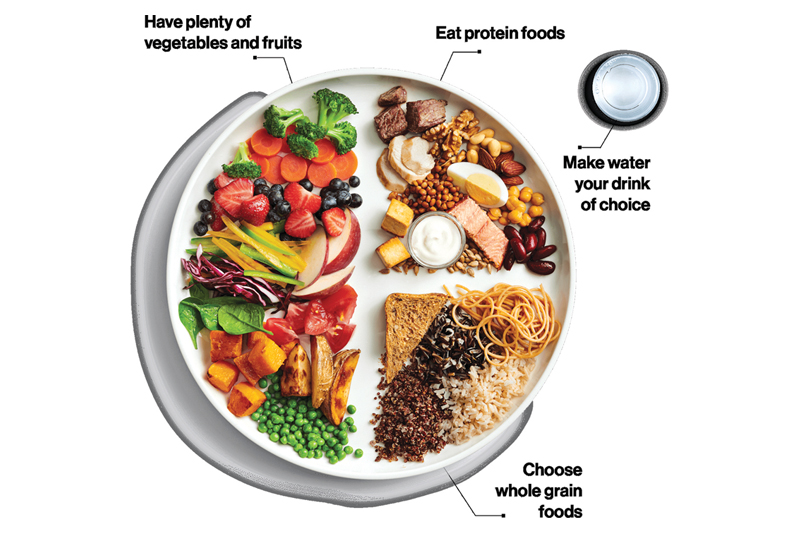The new Canada Food Guide is leaving portion sizes in the past and encouraging people to make healthy eating choices within their own boundaries. Guidelines promote eating plenty of vegetables and fruit, eating protein foods, choosing whole grain foods and making water the drink of choice, as seen in the guide’s official visual. Courtesy photo
MONTREAL – The latest instalment of Canada’s Food Guide to help dieticians, nutritionists, academics and every-day Canadians make their food choices for themselves and patients was launched Jan. 22 in Montreal.
The Honourable Ginette Petitpas Taylor, Minister of Health, emphasized that healthy eating is about more than the foods Canadians eat, said the later press release.
Health Canada has said that the “new food guide is an online suite of resources that better meets the needs of different users, including the general public, policy makers and health professionals. This includes mobile-friendly web content to encourage Canadians to eat healthy whenever and wherever they go.”
The new dietary guidance includes concrete advice for Canadians on healthy food choices and healthy eating habits. Some of this advice includes: eating plenty of vegetables and fruit, eating protein foods, choosing whole grain foods, and making water the drink of choice.
During the revision process, many have been concerned that the new guide could exclude significant food groups, particularly dairy. Producers across the country were left waiting to hear as those writing the new guide said they made sure not to accept input from industry or interest groups during the process.
While media were told that by no means was dairy excluded completely from the guide, recommendations aim to promote options like low-fat milk, low-fat yogurt and cheese that is lower in fat and sodium.
“Dairy Farmers of Canada remain concerned that the updated food guide does not reflect the most recent and mounting scientific evidence available. There is abundant research that demonstrates that milk products with various fat content can be apart of a healthy diet,” said a release from the Dairy Farmers of Canada, after the launch of the guide.
“While the food guide has changed, milk products continue to play a valuable role in helping Canadians make healthy-eating decisions on a daily basis,” says Isabelle Neiderer, director – nutrition and research at Dairy Farmers of Canada. “The scientific evidence supporting the nutritional benefits of milk products in the promotion of bone health and prevention of chronic diseases, for instance, is stronger than ever, and new evidence continues to accumulate,” she added. “Current and emerging scientific evidence does not support a continued focus on lower fat milk products as it reveals that milk products, that contain more fat are not associated with harmful health effects and could even provide benefits.”
However any research that was industry funded supporting this claim was not used during the food guide process. “The bottom line is the guide is basing recommendations on solid scientific evidence,” Dr. Hasan Hutchinson, director general of Health Canada’s office of nutrition policy and promotion, told reporters.
The new guide also focuses on the ways that healthy eating is more than the foods Canadians consume. The food guide encourages Canadians to: cook more often, enjoy food, be mindful of eating habits, and eat meals with others.
“Healthy eating is more than the foods you eat. It’s about your whole relationship with food. The new food guide gets to the heart of this relationship and gives Canadians concrete advice that they can follow to make healthy eating part of their day,” said Ginette Petitpas Taylor, Minister of Health.
The press release explained that Health Canada is working to ensure that the revised food guide is inclusive of Indigenous Peoples, reflecting social, cultural and historical context. Additionally, Health Canada and Indigenous Services Canada are committed to working with First Nations, Inuit and Métis to support the development of distinctions-based healthy eating tools, as part of the revision process.
“Healthy eating is an important part of maintaining a healthy lifestyle and helps prevent chronic diseases like type 2 diabetes, heart disease, and some cancers. The new Canada’s Food Guide not only encourages healthy eating for all Canadians, but also teaches us that healthy eating is more than the foods we eat – it includes such important aspects as sharing meals with others, cooking more often and eating mindfully,” said Dr. Theresa Tam, chief public health officer of Canada
The guide mainly has done away with portion sizes and serving quantity and replaced it with guidance for eating habits. In the official graphic, the plate of food is dominated with fruits and vegetables on half, grains on one quarter and protein on the final quarter. The graphic helps reaffirm the message that half of the food Canadians consume should be fruits and vegetables.
The guide shows parallels to the information produced by other countries around the globe, re-evaluating their nutritional advice. However, despite the move in nutritional information to increase fruit and vegetable intakes, a University of Guelph led study in 2018 revealed that “fruits currently make up only 28 per cent of global fruit and vegetable production. Moreover, of global vegetable production, almost 40 per cent consists of starchy vegetables such as cassava and potatoes.”
This means that while the guide recommends a 50 per cent fruit and vegetable diet, roughly 15 servings per day, global agriculture only produces five servings per person per day according to Food and Agriculture Organization of the United Nations (FAO) data.
The study concluded that if practices shifted in global agriculture to reflect the suggested balanced diets of nutritionists it could help current land become more efficient in feeding the growing population.
“The data suggest that adopting nutritionally balanced diets that involve a greater consumption of fruits and vegetables, plus lower consumption of grains, fats and sugars, along with developing proteins that require less land to produce should help to ensure sustainable and balanced diets through the coming decades.”













